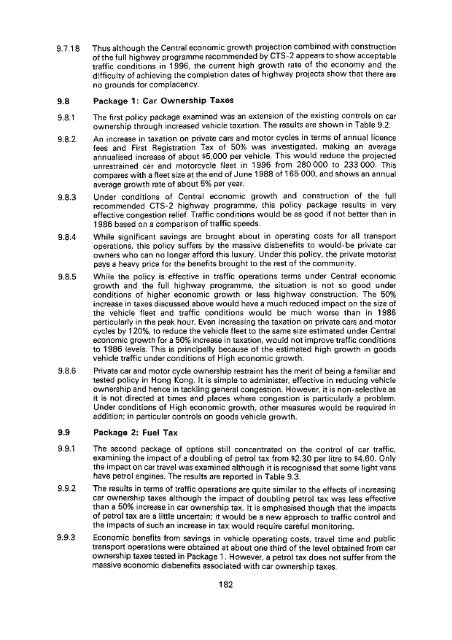Untitled - HKU Libraries - The University of Hong Kong
Untitled - HKU Libraries - The University of Hong Kong
Untitled - HKU Libraries - The University of Hong Kong
- No tags were found...
You also want an ePaper? Increase the reach of your titles
YUMPU automatically turns print PDFs into web optimized ePapers that Google loves.
9.7.18 Thus although the Centra! economic growth projection combined with construction<strong>of</strong> the full highway programme recommended by CTS-2 appears to show acceptabletraffic conditions in 1996, the current high growth rate <strong>of</strong> the economy and thedifficulty <strong>of</strong> achieving the completion dates <strong>of</strong> highway projects show that there areno grounds for complacency.9.8 Package 1: Car Ownership Taxes9.8.1 <strong>The</strong> first policy package examined was an extension <strong>of</strong> the existing controls on carownership through increased vehicle taxation. <strong>The</strong> results are shown in Table 9.2.9.8.2 An increase in taxation on private cars and motor cycles in terms <strong>of</strong> annual licencefees and First Registration Tax <strong>of</strong> 50% was investigated, making an averageannualised increase <strong>of</strong> about $5,000 per vehicle. This would reduce the projectedunrestrained car and motorcycle fleet in 1996 from 280000 to 233000. Thiscompares with a fleet size at the end <strong>of</strong> June 1988 <strong>of</strong> 165 000, and shows an annualaverage growth rate <strong>of</strong> about 5% per year.9.8.3 Under conditions <strong>of</strong> Central economic growth and construction <strong>of</strong> the fullrecommended CTS-2 highway programme, this policy package results in veryeffective congestion relief. Traffic conditions would be as good if not better than in1986 based on a comparison <strong>of</strong> traffic speeds.9.8.4 While significant savings are brought about in operating costs for all transportoperations, this policy suffers by the massive disbenefits to would-be private carowners who can no longer afford this luxury. Under this policy, the private motoristpays a heavy price for the benefits brought to the rest <strong>of</strong> the community.9.8.5 While the policy is effective in traffic operations terms under Central economicgrowth and the full highway programme, the situation is not so good underconditions <strong>of</strong> higher economic growth or less highway construction. <strong>The</strong> 50%increase in taxes discussed above would have a much reduced impact on the size <strong>of</strong>the vehicle fleet and traffic conditions would be much worse than in 1986particularly in the peak hour. Even increasing the taxation on private cars and motorcycles by 120%, to reduce the vehicle fleet to the same size estimated under Centraleconomic growth for a 50% increase in taxation, would not improve traffic conditionsto 1986 levels. This is principally because <strong>of</strong> the estimated high growth in goodsvehicle traffic under conditions <strong>of</strong> High economic growth.9.8.6 Private car and motor cycle ownership restraint has the merit <strong>of</strong> being a familiar andtested policy in <strong>Hong</strong> <strong>Kong</strong>. It is simple to administer, effective in reducing vehicleownership and hence in tackling general congestion. However, it is non-selective asit is not directed at times and places where congestion is particularly a problem.Under conditions <strong>of</strong> High economic growth, other measures would be required inaddition; in particular controls on goods vehicle growth.9.9 Package 2: Fuel Tax9.9.1 <strong>The</strong> second package <strong>of</strong> options still concentrated on the control <strong>of</strong> car traffic,examining the impact <strong>of</strong> a doubling <strong>of</strong> petrol tax from $2.30 per litre to $4.60. Onlythe impact on car travel was examined although it is recognised that some light vanshave petrol engines. <strong>The</strong> results are reported in Table 9.3.9.9.2 <strong>The</strong> results in terms <strong>of</strong> traffic operations are quite similar to the effects <strong>of</strong> increasingcar ownership taxes although the impact <strong>of</strong> doubling petrol tax was less effectivethan a 50% increase in car ownership tax. It is emphasised though that the impacts<strong>of</strong> petrol tax are a little uncertain; it would be a new approach to traffic control andthe impacts <strong>of</strong> such an increase in tax would require careful monitoring.9.9.3 Economic benefits from savings in vehicle operating costs, travel time and publictransport operations were obtained at about one third <strong>of</strong> the level obtained from carownership taxes tested in Package 1. However, a petrol tax does not suffer from themassive economic disbenefits associated with car ownership taxes.182
















